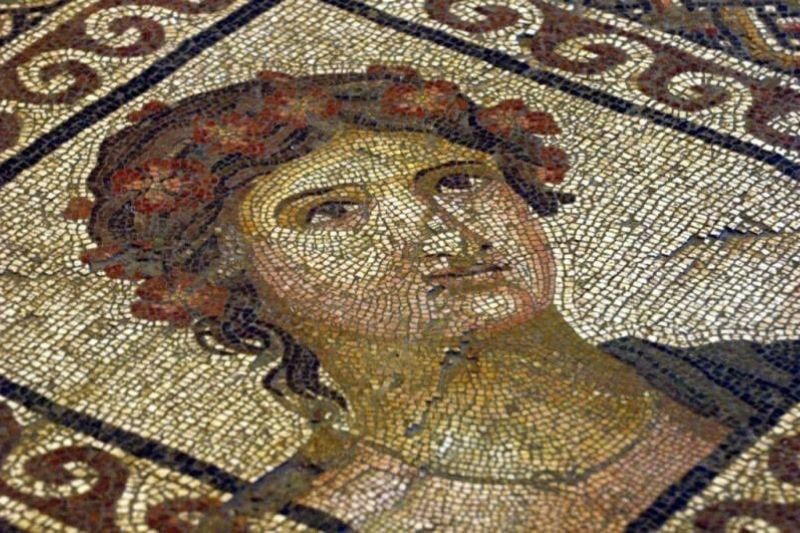
Amisos Mosaic depicting Achilles and Thetis in the Ancient City of Amisos
The Amisos Mosaic was discovered in 1958 during excavation works in the ancient city of Amisos.
The central panel in the center of the Amisos Mosaic, which has a base size of 56 m2, depicts Achilles and Thetis, and there are inscriptions on the heads of the figures indicating their identity.
This panel depicts the mother Thetis handing over her arms to her son Achilles. In Homer’s Iliad, it is narrated that mother Thetis explains her bad fate in the Trojan War while handing over her weapon to her son Achilles. The fact that Thetis is rendered in the pudicita type depicting sadness shows the iconographic difference of the Amisos Mosaic.

The corner panels around the central panel feature busts personifying the four seasons. Autumn, summer, spring and winter are characterized by male and female figures combined with plants.
Between the corner panels are four panels with differently rendered Hippocampus, sea creatures (with panther and dragon heads) and Nereids carried by Triton. The common feature of these panels is the Nereid’s journey on mythological sea creatures with fish tails.

One of the most interesting depictions of the Amisos mosaic is the panel depicting the sacrifice scene. The panel depicts the host, holding an offering bowl, sacrificing a bull with the help of a butcher. The fact that this panel corresponds to the panel of Achilles suggests that the two panels may be related to each other. Therefore, the panel depicts a sacrificial ritual dedicated to Achilles by the owner of the house to which the mosaic belongs.
Compositional areas are surrounded by geometric motifs. There are eleven different geometric patterns as complementary motifs on the Amisos Mosaic.

It was understood after archaeological studies that the Amisos Mosaic was made by traveling masters from the south. In the panel with Achilles and Thetis, the inscription below the figures states that the mosaic was made by the master named ‘Orentes’. When the technique and workmanship of the mosaic are evaluated, it is understood that it was made in the first half of the 3rd century AD during the reign of Roman Emperor Alexander Severus and that it is the floor of a Roman villa.
Amisos Mosaic is exhibited in Samsun Museum.
Source: Samsun governorship
Cover Photo: Samsun Provincial Directorate of Culture and Tourism
You may also like
- A 1700-year-old statue of Pan unearthed during the excavations at Polyeuktos in İstanbul
- The granary was found in the ancient city of Sebaste, founded by the first Roman emperor Augustus
- Donalar Kale Kapı Rock Tomb or Donalar Rock Tomb
- Theater emerges as works continue in ancient city of Perinthos
- Urartian King Argishti’s bronze shield revealed the name of an unknown country
- The religious center of Lycia, the ancient city of Letoon
- Who were the Luwians?
- A new study brings a fresh perspective on the Anatolian origin of the Indo-European languages
- Perhaps the oldest thermal treatment center in the world, which has been in continuous use for 2000 years -Basilica Therma Roman Bath or King’s Daughter-
- The largest synagogue of the ancient world, located in the ancient city of Sardis, is being restored











Leave a Reply